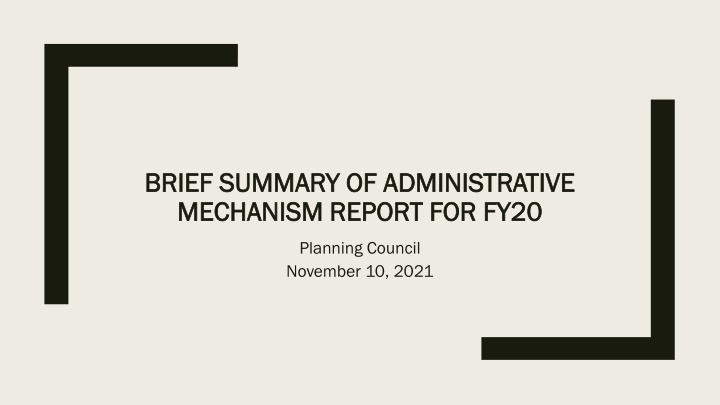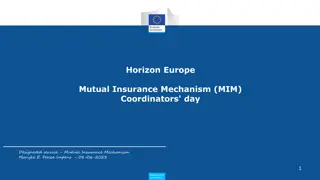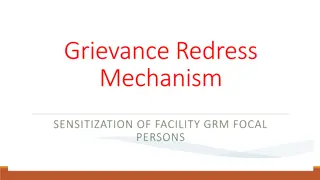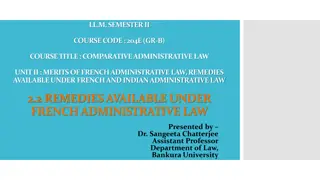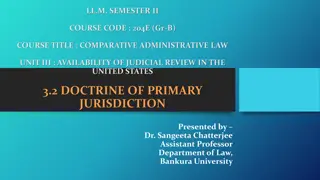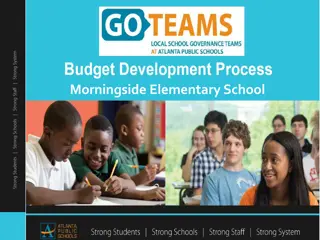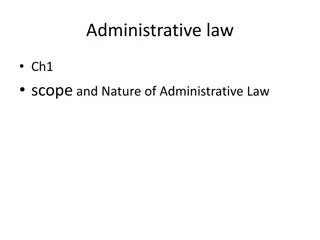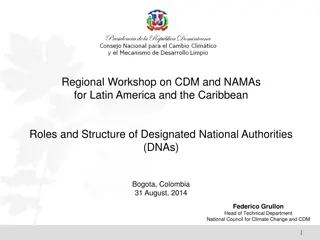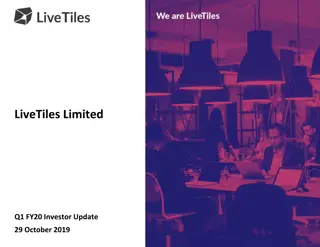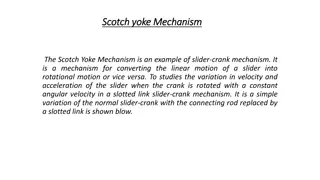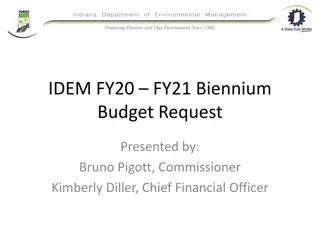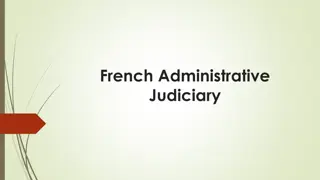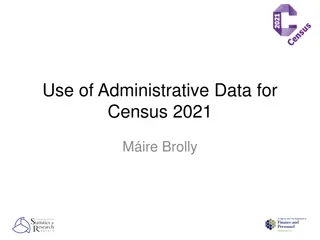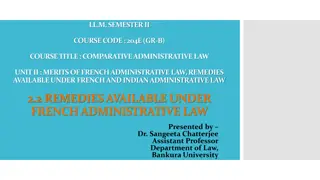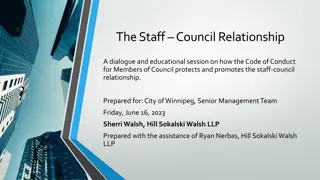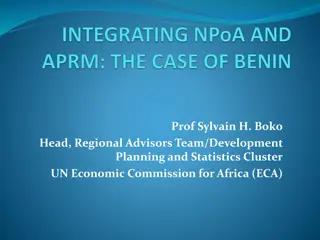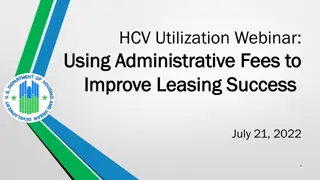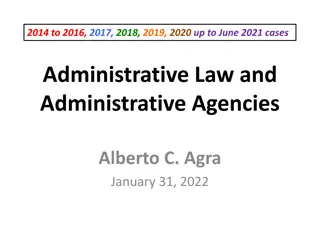Administrative Mechanism Assessment for FY20 Planning Council
The report outlines the assessment of the administrative mechanism for the Ryan White HIV/AIDS Program, focusing on efficiency in fund allocation and service effectiveness. It discusses the role of the Planning Council in ensuring timely and effective service delivery to people living with HIV/AIDS.
Download Presentation

Please find below an Image/Link to download the presentation.
The content on the website is provided AS IS for your information and personal use only. It may not be sold, licensed, or shared on other websites without obtaining consent from the author.If you encounter any issues during the download, it is possible that the publisher has removed the file from their server.
You are allowed to download the files provided on this website for personal or commercial use, subject to the condition that they are used lawfully. All files are the property of their respective owners.
The content on the website is provided AS IS for your information and personal use only. It may not be sold, licensed, or shared on other websites without obtaining consent from the author.
E N D
Presentation Transcript
BRIEF SUMMARY OF ADMINISTRATIVE BRIEF SUMMARY OF ADMINISTRATIVE MECHANISM REPORT FOR FY20 MECHANISM REPORT FOR FY20 Planning Council November 10, 2021
Administrative Mechanism The Ryan White HIV/AIDS Program (RWHAP) legislation requires each Part A program s planning council to assess the efficiency of the administrative mechanism in rapidly allocating funds to the areas of greatest need within the eligible area and at the discretion of the planning council, assess the effectiveness, either directly or through contractual arrangements, of the services offered in meeting the identified needs. [Section 2602(b)(4)(E)]. This responsibility is generally referred to as the assessment of the administrative mechanism or AAM.
Administrative Mechanism continued The AAM is a review of how quickly and well the Part A recipient (and administrative agency, in this case United Way) carries out the processes needed to contract with and pay providers for delivering HIV-related services, so that that the needs of people living with HIV/AIDS (PLWH) throughout the Part A service area are met. Emphasis is on ensuring services to PLWH and to communities with the greatest need for Ryan White services. If the administrative mechanism is not working well, the Planning Council is responsible for making formal recommendations to the CEO of the EMA, in order to continue the timeliness and effectiveness of the contracting process.
Responsibility and Process The Clinical Quality Management Committee of the Planning Council is responsible for conducting an annual assessment of the Nassau-Suffolk EMA s administrative mechanism In 2021, surveys were sent to both Planning Council members and to Part A funded providers. Questions for members were specific to the Council, its mission, trainings, and the PSRA process. Provider questions focused on distribution of funds in FY 20-21, contracting, contract monitoring, and knowledge of PSRA process. Both surveys reviewed the previous year s planning process and the resulting priorities that are funded in the current fiscal year.
Summary Summaryof Results of Results The survey results confirm that the EMA is effective at both allocating and reallocating funds to priorities that mirror the needs of the region and that are supported through needs assessments and data collection. Over 93% of providers (an increase over the previous year) were familiar with the PSRA process and the overwhelming majority agreed the process is data driven and addresses the needs of special populations. A small percentage of both PC members and providers, less than 8%, replied that the needs of IDU were not considered; 4,55% of members did not think that the needs of MSM were considered in the planning process. Council members indicated a clear understanding of the PSRA process (a key component of the administrative mechanism). All (100%) replied that they were familiar with the process and 90.91% reported participating in the process through Planning Council and committee meetings . 85.71% of providers replied that contracting changes made it easier for agencies to get contracted; 78.57% responded that vouchering changes simplified the vouchering process. All respondents agreed that the process is both data driven and an overwhelming majority reported that the needs of special populations were addressed. All agencies were monitored and received a comprehensive site visit in FY 20-21. All respondents agreed that contract managers and fiscal staff were accessible, and that technical assistance, when requested was reported as both timely and helpful.
The COVID-19 pandemic forced the EMA to re-examine the way it approached its planning processes, contracting and vouchering systems in FY20. Changes to EMA processes in response to the COVID-19 Pandemic Specifically, the Planning Council had to adjust the manner in which meetings and the PSRA process were conducted. All meetings were moved to a virtual platform. United Way had to amend its contracting process, the process for submitting and approving vouchers and how programs would be monitored when many providers were operating remotely. Finding/Recommendation Finding/Recommendation: A A significant number number of survey respondents of survey respondents recommended keeping recommended keeping many of the changes that were implemented changes that were implemented in place. significant many of the in place.
An identified deficiency is the need for the EMA to continue working towards shortening the length of time for processing vouchers. While 85.71% of providers responded that vouchers were paid in a timely manner approximately half also indicated that the average time for UWLI to reimburse an agency once a complete contract had been submitted was over 30 days. Area 1: Timeliness of Payments Upon further examination, it was found that some of the delays were due to missing documentation, voucher error or late submission. Once contracted, 93% of vouchers were paid within one month. Length of time to pay voucher once received 1st Voucher Submitted Vouchers 1st paid 7/2/2020 8/20/20201 month However, while not mentioned by survey respondents, it was deemed that contracting delays had an impact on the perception of late payments. From the time CFAs were sent to the date of signature could took up to 4 months in 2020. 7/1/2020 8/20/20201 month 7/3/2020 8/24/20201 month 2/26/2021 5/21/20213 months 7/22/2021 8/20/20201 month 1/15/2021 2/16/20211 month 6/20/2020 7/22/20201 month 11/10/2020 12/11/20201 month Finding/Recommendation Finding/Recommendation: In general, p payments are timely timely. ACH deposits implemented in 2021 will continue ACH deposits implemented in 2021 will continue to have an greater impact on timeliness. to have an greater impact on timeliness. ayments are 9/22/2020 9/22/2020same day 7/1/2020 7/22/20201 month 12/24/2020 1/14/20211 month 9/15/2020 10/6/20201 month Finding/Recommendation Finding/Recommendation: : Continue to examine contracting process. contracting process.New New multi greatly reduce the contracting time moving forward. greatly reduce the contracting time moving forward. Continue to examine multi- -year funding should year funding should 11/24/2020 11/24/2020same day 8/31/2021 10/2/20201 month 7/1/2020 7/1/2020same day
Area 2: Program Monitoring Conducting site visits virtually was challenging but all were completed in FY2020 and provider requirements were minimized to reduce burden as much as possible. While in-person site visits are preferable and viewed as easier by some providers, given the current health crisis, visits will continue as virtual in FY21. Recommendation Recommendation: Provider survey respondents suggested the addition of respondents suggested the addition of mid mid- -year year or quarterly check or quarterly check- -ins and meetings between contract administrators meetings between contract administrators and and providers providers in in addition to site addition to site visits. : Provider survey ins and visits.
